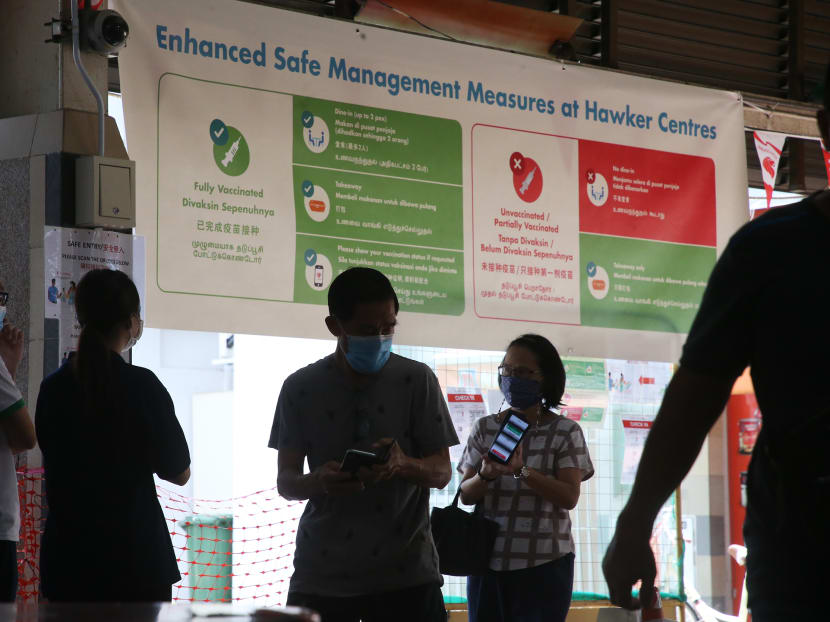Hawkers welcome larger dine-in groups but some worry access controls may be hard to enforce
SINGAPORE — Stallholders at hawker centres and coffee shops welcome the latest ruling that fully vaccinated people from the same household will soon be able to eat at these places in groups of five, but they question the operational challenges that may surface.

Patrons undergoing checks at the entry point of Ang Mo Kio Central Market & Food Centre on Oct 17, 2021.
- For now, vaccinated customers are allowed to eat at hawker centres and coffee shops only in groups of up to two
- Those who are not vaccinated or partially vaccinated can only enter hawker centres to buy takeaway food
- MOH said on Nov 15 that new control and checking systems will be put in place to let up to five from the same household to eat at these premises
- Though details have not been announced, some hawkers told TODAY they worry that the systems will be an inconvenience
SINGAPORE — Stallholders at hawker centres and coffee shops welcome the latest ruling that fully vaccinated people from the same household will soon be able to eat at these places in groups of five, but they question the operational challenges that may surface.
Some of the seven stallholders interviewed by TODAY on Tuesday (Nov 16) were confused over how the proposed access control and checking systems will be able to ensure that people who remain unvaccinated do not eat out at these places.
Ms Amber Pong, 30, who runs The Headless Baker stall at the hawker centre on Ghim Moh Road, said: “It will help businesses when families are able to eat out and I think it’s good that the Government is implementing this, but at the end of the day, you can’t restrict the unvaccinated.
“Hawker centres are too big to keep conducting checks on who is sitting down and eating. Only random ones can be done.”
For now, customers are only allowed to eat at hawker centres and coffee shops in groups of up to two, regardless of whether they are from the same household, because it is challenging to enforce vaccine-related controls in these settings.
The Ministry of Health (MOH) said on Monday that the first group of hawker centres are expected to have new access control systems in place before the end of this month. The authorities are working with stallholders to look at setting up the systems.
For coffee shops, the Singapore Food Agency has similarly been engaging the operators and will provide them with the option of putting in place a system to control access and check the vaccination status of their patrons, to allow people from the same household to dine in groups of five.
For up to five people from the same household who are eating out together, MOH added that it will expand the list of acceptable documents to check for proof of residence, from identity cards and Singpass mobile applications to approved government digital apps such as myICA and SGWorkPass.
Mr Kelly Ng, who has been running his laksa stall at the Ghim Moh hawker centre for the past five years, said that the challenge lies in “what and how a hawker centre is”,
“It is basically a communal eating place with an open concept. So no fixed entry points in its original design and it is usually paired with a wet market,” the 49-year-old hawker said.
“Coupled with fencing and dual or multiple entry points, the monitoring of crowd numbers becomes harder especially during peak times and weekends.
“Added to this is the checking of unvaccinated (people) at the tables, which strains the ability to effectively combat against rule-breakers,” Mr Ng added.
Those who are not vaccinated or partially vaccinated can only enter hawker centres to buy takeaway food. Exceptions are made for children aged 12 and below, who can eat at hawker centres even if they are not vaccinated.
Mr Darren Teo, who has been running 51 Noodle House stall at Yishun Park Hawker Centre for four years, said that the differentiation “will for sure be difficult as tables are free seating”, suggesting that colour-coded stickers should be given to patrons to distinguish if they are vaccinated or not.
“But we are really fortunate these measures will be implemented by the National Environment Agency (NEA) or hawker-appointed management at no extra cost for us. With this, it will improve businesses, why not?” he said.
Currently, at hawker centres and coffee shops, the customers’ vaccination status will be randomly checked by enforcement officers.
CONCERNS OVER LONG QUEUES
More details on what the new processes will look like have not been announced.
However, Mr Tom Loo, 36, a stallholder at the Ghim Moh food centre selling noodles, are anticipating that longer queues will form at access points where checks are done, causing a “very irritating inconvenience”.
“Of course, it will affect the business. The flow will be slow since the entrance queues will take some time for the people to come in.
“It is still a good safety measure overall, I just hope that everything goes well and smoothly once the system is up,” he said.
Mr Ng agreed that with the formation of queues due to unfamiliarity with the checks or slower processing of entry, reduced footfall is inevitable.
“But for the well-being and safety of everyone, some give-and-take must be accepted,” he said.
Ms Elayne Ang, 40, who runs a carrot cake and Hokkien mee stall at 84 Marine Parade Hawker Centre, does not think that the upcoming access control and checking systems will be “workable”.
At the moment, hawker centres are already “blocked up” and business is badly affected due to the limited access and reduced sitting capacity, she said.
“It will add unnecessary workload to hawkers and we can only check the person who buys the food and not the rest of the people who are with him or her.
“Also, even if the customer opts for takeaway, there is nothing to prevent the customer from taking a seat and opening up the takeaway packet in the hawker centre and start eating,” she said.
Ms Ang added that enough manpower needs to be allocated by the relevant government agencies to conduct extensive checks throughout the hawker centre all through the day.
“If the Covid-19 multi-ministry task force still feels insecure about letting diners sit in a well-ventilated environment to have a meal, then it is its decision to incur all the manpower costs necessary to do the checks.”
ZI CHAR, STEAMBOAT STALLS 'SUFFERING THE MOST'
Mr Koh Ming Wei, 21, who has been running a carrot cake stall at Cheng San Market & Cooked Food Centre for seven months, is worried that patrons who find these new systems troublesome might avoid hawker centres altogether.
“Imagine having to queue to enter the hawker centre and then queueing for food. A lot of time will be wasted. Not to forget, some people might have limited time for their meals.
“This will lead to many hawkers' businesses being affected very badly as people tend to get lazy to enter the hawker centre. Customer feedback is that they would rather order delivery,” he added.
Ms Elenda Quek who runs a carrot cake stall in a coffee shop at Block 21, Old Airport Road, said that ultimately, it is “all about making entry and exit efficient and convenient for all”.
“I feel it’s difficult because hawker centres are very busy and crowded places, especially on weekends. And everyone just wants to get their business done. Everything is very fast-paced and no one really bothers if one is vaccinated because many people assume that we all are.
“For sure, business will be affected. With one access point, it will cause a lot of inconvenience and might even cause bottleneck situations and safe distancing issues.
“As much as it will cause some inconvenience or unhappiness, it is still necessary since these systems keep all of us safe as much as possible. If people want to dine out, they should know what to expect.”
Mr Tan Ming Han, 35, vice-secretary of the Chinatown Complex Hawkers’ Association, told TODAY that several representatives of the respective hawkers associations, in a meeting on Nov 10 with NEA and Dr Amy Khor, Senior Minister of State for Sustainability and Environment, had expressed concerns that these new processes “should not affect the livelihoods of hawkers”.
“It has been well-noted. They understand that whatever it is, we cannot jeopardise the rice bowl of the hawkers,” he said.
Until details of the access control measures are announced, Mr Tan said that he could not comment on what people are saying about how it might work.
“For hawkers selling zi char (stir-fried food) and steamboat, usually it’s a family-oriented, (a) whole-table kind of eating affair. These kinds of stalls have been suffering the most and for the longest time,” Mr Tan added .
“With these slightly more relaxed measures, it’s definitely going to benefit them and for those who have been going through a hard time, this is really the light at the end of the tunnel. Hopefully, there will not be any more tightening of measures.
“This is a positive thing. If the access controls are done right, if they are able to differentiate those who are vaccinated and unvaccinated very clearly and with the correct manpower that they have allocated, I feel that this will be a very safe and conducive environment in which to have meals.”








